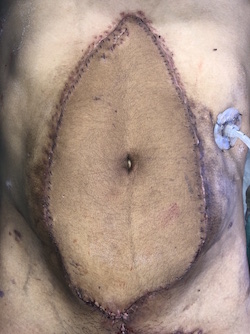For years after having perforated appendicitis in early childhood, a man underwent multiple surgeries for repeated intestinal blockages. One morning, when he was 33 years old, he could not stop vomiting, and he rushed to his local emergency department. There, he was operated on again, but the additional surgery caused severe damage to his small intestines, and he developed intestinal fistulas through his abdominal wall. The hospital recommended that his family consider admitting him to hospice care.
In a final effort to find another option for the patient, the hospital transferred him to Duke. The Duke surgical team was able to stabilize his condition but was unable to restore his ability to eat because of the lack of function of his small bowel. He was placed on total parenteral nutrition (TPN).
A few years later, he developed a serious infection from the TPN, putting his life in grave danger. Although the Duke physicians could treat his infection, the only long-term solution to his condition would be a small bowel transplant. However, scarring and fistulas from the previous surgeries had left insufficient abdominal wall muscle and skin tissue to accommodate the transplanted organ.
Question: What rare procedure did Duke perform to restore the patient’s ability to eat and enjoy some quality of life?
Answer: A 25-member team consisting of surgeons, anesthesiologists, nurses, and operating room staff performed North Carolina and the region’s first simultaneous abdominal wall and small bowel transplant. The surgery included a first-of-its-kind method of simultaneous revascularization of the abdominal wall and small bowel.
A rare procedure that has only been performed 20 times since 1998, the abdominal wall transplant required that Duke abdominal transplant surgeons Debra Sudan, MD, and Kadiyala Ravindra, MBBS, as well as plastic surgeon Detlev Erdmann, MD, PhD, MHSc, undergo specialized training and apply for a number of special permissions.
One significant challenge of the combined procedures would be to prevent logistical interference between the two surgeries. Ideally, the surgeons would need to be in close proximity at the same time—performing the surgeries sequentially would dramatically reduce the chances that the abdominal wall graft would survive.
To address this, Erdmann developed an innovative way to reconnect the blood supply to the abdominal wall by creating a vascular loop at the thigh level, allowing both transplantations to take place simultaneously without interfering with each other.
He had spent years refining the method in the lab, even inviting a specialist from the United Kingdom to help him prepare. The new technique will likely enable many more patients to benefit from organ transplant, Erdmann says. “There are other patients in this same scenario—who need an organ transplant but have problems with the abdominal wall,” he explains. “Surgeons can’t perform transplantation without proper closing of the abdomen. I think that this modification will open the door to many more patients in the same situation, and I’m looking forward to all the things that can happen in the future.”
 The surgery required careful coordination of several teams at Duke, lasting a total of 14 hours. While Ravindra and others worked at the donor hospital to prepare the organs, Sudan and Erdmann and their teams worked at Duke to prepare the aorta and vena cava and create the vascular loop for reperfusion and transplantation of the intestine and abdominal wall, respectively.
The surgery required careful coordination of several teams at Duke, lasting a total of 14 hours. While Ravindra and others worked at the donor hospital to prepare the organs, Sudan and Erdmann and their teams worked at Duke to prepare the aorta and vena cava and create the vascular loop for reperfusion and transplantation of the intestine and abdominal wall, respectively.
Once the organs arrived at Duke, Sudan, aided by Ravindra, transplanted the intestine while Erdmann and his team of plastic surgeons, including Suhail Mithani, MD, and Brett Phillips, MD, transplanted the abdominal wall. Weeks later, the patient was able to eat and left the hospital.
“This patient has lived through so much pain from scarring in his abdomen and his fistulas, not to mention his severe infection that nearly took his life last year,” Sudan says. “So we were very grateful for the gift from a donor family. It was really remarkable when this all came together. I’m very excited about the patient’s full recovery.”

